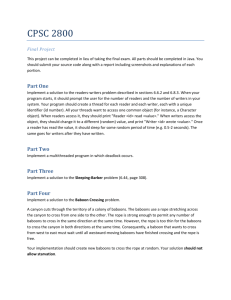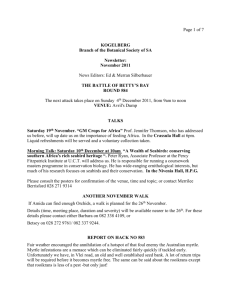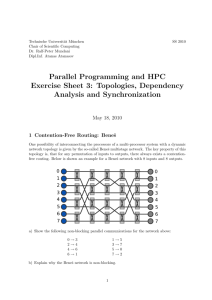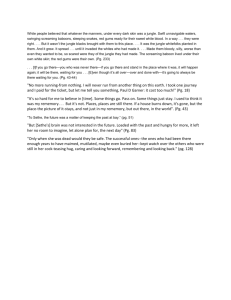PROTOCOL for reducing the frequency and
advertisement
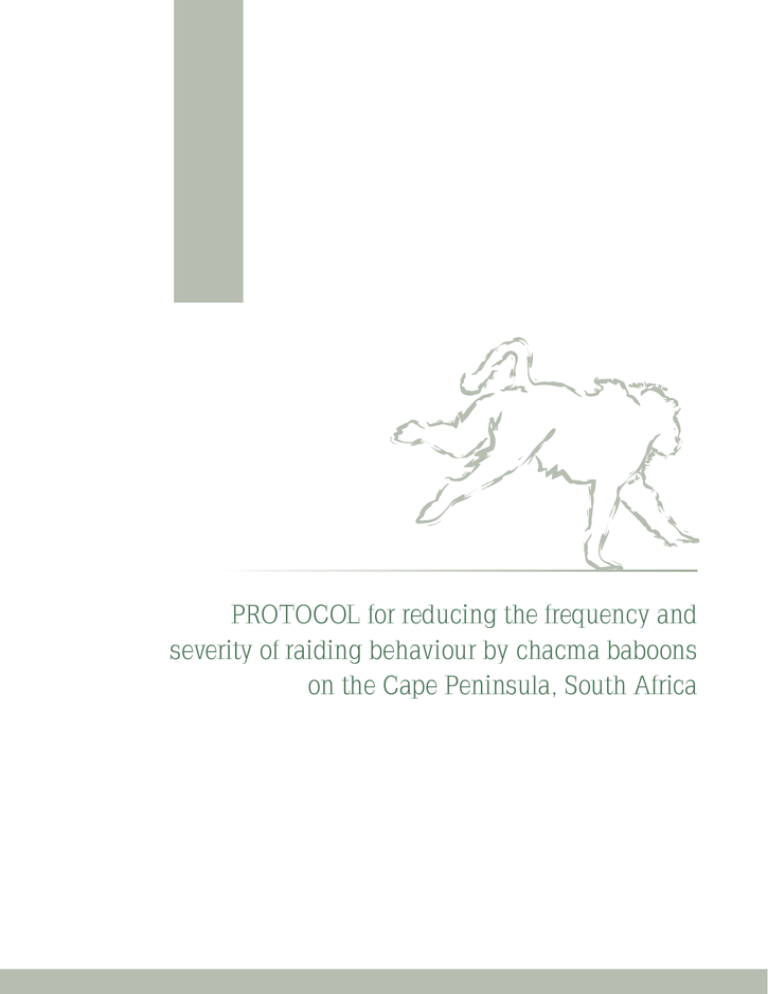
PROTOCOL for reducing the frequency and severity of raiding behaviour by chacma baboons on the Cape Peninsula, South Africa PROTOCOL for reducing the frequency and severity of raiding behaviour by chacma baboons on the Cape Peninsula, South Africa THE THREE AUTHORITIES involved in baboon management on the Cape Peninsula, namely South African National Parks, the City of Cape Town and CapeNature – also known as the Baboon Conservation Authorities (BCA), have adopted a protocol to address the management of raiding baboons in municipal areas on the Cape Peninsula. This protocol guides both long term management plans and short term interventions to reduce the frequency and severity of raiding behaviour that is considered to be a threat to human health and safety and may result in damage to property. Relevant background information The BCA continually seeks to advance baboon conservation on the Cape Peninsula in accordance with relevant local and international research findings and international guidelines for the management and conservation of wildlife in conflict with humans. In 2010 the BCA revised the existing strategy for the management of raiding baboons as described in the Baboon Management Strategy. The main driver for this revision was the lack of an integrated decision making process to ensure firstly, that short and long term management plans are being implemented to reduce the frequency and severity of baboon raiding behaviour and secondly that mitigating factors such as extensive fires or drought are considered when managing raiding baboons that are part of a geographically isolated and spatially restricted population. Furthermore the new protocol demands that both qualitative and quantitative data are recorded so that all management decisions relevant to raiding baboons can be subject to an independent assessment by recognised wildlife management experts, local and international researchers with relevant expertise and elected civic representatives living on the Peninsula (i.e. the Baboon Liaison Group which is made up of representatives from the Constantia Property Owners Association, Scarborough Residents & Ratepayers Association, Kommetjie Residents & Ratepayers Association, Misty Cliffs Village Association, Ocean View Civic Association and the Simon’s Town Civic Association). Lastly, it was considered essential that management decisions concerning the future of specific raiding baboons should be deliberated by experienced wildlife managers (i.e CapeNature’s Wildlife Advisory Committee – WAC) that themselves are not directly affected by raiding on the Peninsula. Previously such decisions were made by the Baboon Management Team (BMT) which included individuals that were directly affected (both personally and professionally) by baboon management decisions. The current process The WAC is provided with a detailed case history for each raiding baboon that is considered to be potentially dangerous to public health and safety in spite of management changes to rectify the perceived threat. The case history is compiled following the combined input of the current service provider, local residents, conservation authorities and both local and international researchers actively working with baboons on the Peninsula. This case history includes the estimated age, social status, history of management interventions, current troop, and troop of origin and the known history of raiding and management interventions implemented to prevent and/or reduce the severity and frequency of such raids. This case history is then assessed using a decision framework in the form of a checklist that details the health, current raiding behaviour (type and frequency) and the potential impact of current raiding behaviour on other baboons in the population. Health and raiding behaviour are then assessed within the context of the individuals’ current social and physical environment. This ensures that factors which may have promoted the onset and persistence of the particular raiding behaviour are considered as potential mitigating factors and enables the authorities to focus attention on reducing the impact of such factors on future raiding behaviour in the area. Thus for example, in the physical environment, a severe drought or extensive fire are considered as potential mitigating factors when assessing the raiding behaviour of an individual. In the process of assessing the case history and checklist documents there is no one single category of raiding that either results in a decision to euthanise a baboon (e.g. enter cars with people) or mitigating factors (e.g. alpha status) that prevents it from being euthanised (e.g. alpha male status). Rather the weight of evidence for and against euthanasia is assessed in its entirety, from the case history and behaviour of the baboon through to the social and physical environment it lives in. The WAC have to draw upon their collective experience and expertise in wildlife management to weigh up the threat posed by the individual to public health and safety and the previous, current and proposed management plans to prevent this behaviour or its emergence in other baboons within that area. A baboon is only considered for euthanasia when the BCA can demonstrate to the WAC that they have implemented short and long term management plans (subject to budgets, manpower, time constraints and accepted conflict mitigation tools) to curb the raiding behaviour (e.g. introduced monitors) and reduce the probability that other baboons will acquire similar behaviour. Sequence of Events FOR IMPLEMENTATION OF RAIDING BABOON PROTOCOL Baboon behaviour confirmed as posing a threat to public health and safety. Case history is compiled. Case history is discussed at monthly BCA and BLG meetings. Short and long term management plans to reduce frequency and severity of raiding by individual baboon are approved in consultation with NCC and BRU. Service provider, BCA and BLG implement management plans and success/failure of these plans are discussed at monthly BCA and BLG meetings and revised accordingly. Raiding baboon continues to pose a threat to public health and safety despite implemented management plans. Submit case history, affidavits from public and checklist to WAC for assessment. WAC reviews case history and completes checklist to assess current behaviour and mitigating factors. WAC makes recommendations to Executive Committee of CapeNature on: 1) further short and long term management interventions required and 2) the future of the raiding baboon, which entails either leaving it alone, subject to changes recommended in 1) above or removal of the individual and implementation of 1) above. Executive committee approves/disapproves WAC recommendations and final decision(s) communicated by WAC to BCA for action. Recommended short and long term management plan changes communicated at monthly BCA and BLG meetings. Definitions RELEVANT TO PROTOCOL FOR RAIDING BABOONS The definitions set out below describe the different parameters that are considered when weighing up the contributing factors for each specific case. These terms are integrated into a single checklist that ensures that the BCA and WAC have applied their minds to all aspects of the raiding behaviour on the one hand and the animals’ social and physical environment on the other. GENERAL TERMS Individual: a single reliably identifiable baboon. Identifying the individual may be achieved through a definitive physical feature (e.g. a permanent scar) but preferably by means of a coloured ear tag that can be used by authorities, monitors, residents and tourists alike to reliably and repeatedly, identify individual baboons. Management intervention: action taken by relevant authorities with regard to an individual raiding baboon e.g. capture, tag, collar, veterinary assessment, translocation, relocate, euthanise. Mitigating factors: factors relevant to a raiding baboon and the social and physical environment it lives in. These factors must be considered by the authorities when deciding on the various management interventions available to them. These factors may have lead to the onset of raiding behaviour or increased the propensity of individual baboons to engage in raiding behaviour. Examples include an extensive natural or man-made fire which may have destroyed all above ground vegetation within a troop’s home range and result in baboons raiding within urban areas to survive until the natural vegetation recovers. Alpha male: the dominant male of the troop. The alpha male is accepted to have an important leadership role within the troop and to engage in mate-guarding of females and protection of offspring (he has a higher probability of paternity than other adult males in the troop). Commercial waste: privately owned waste including bins and refuse areas (e.g. skips and communal bin areas) in light industrial and commercial food outlet areas. These sites are within or immediately adjacent to the home range of an existing troop and are readily accessible to baboons and devoid of effective baboon proofing. Authorities waste: waste sites including bins on POS (public open space, picnic-sites) that are managed by the City of Cape Town, TMNP or National/Provincial authorities within or immediately adjacent to the home range of an existing troop, that are readily accessible to baboons and devoid of effective baboon-proofing. Domestic waste: privately owned waste including bins and refuse areas (e.g. skips and residential bins) in all residential areas (e.g. private houses, housing complexes, flats). These sites are within or immediately adjacent to the home range of an existing troop, and are readily accessible to baboons and devoid of effective baboon-proofing. Houses and gardens: any building or garden area that is readily accessible to baboons and offers the potential of an anthropogenic food item (i.e. no attempt to baboon-proof building or remove incentives such as fruit trees, vegetable gardens and compost heaps) within or immediately adjacent to the home range of an existing troop. Education: information and guidelines that will help companies, authorities, residents and tourists to reduce raiding incentives within and immediately adjacent to the home ranges of existing baboon troops. Law enforcement: the enforcement of laws which are specific to humans and their interactions with baboons. For example the enforcement of the law as it pertains to the feeding of baboons in public spaces such as roads. Monitor team: people employed by the authorities or civic representatives to prevent baboons from entering into selected urban, rural or tourist areas by attempting to scare them with a physical presence. Large scale habitat transformation: transformation of land including urban development and the removal of alien vegetation within natural areas or plantations that have previously sustained baboons either as preferred sleeping sites or foraging areas. Recent extensive fire: a recent fire (last 3 months) that has burnt a large proportion of an existing home range and adjacent natural land. Such conditions may result in a temporary shortage of food and result in the troop shifting their home range to new areas. This movement may result in baboons encountering urban/rural areas with little or no baboon-proofing (i.e. high foraging incentives) and consequently a dramatic increase in opportunistic raiding behaviour. It is possible that troops will not be able to shift their home ranges either due to the presence of neighbouring troops or neighbouring incompatible urban/rural areas. Under these conditions alternative management plans may need to be initiated (e.g. temporary provisioning within natural areas or additional monitors) to alleviate raiding and ensure troop survival during temporary period of food shortage. A severe drought: when severe drought conditions are identified by the relevant authorities. Such conditions are recognised as having greatly reduced both the forage and water availability within the natural and other conservation areas possibly resulting in baboons shifting their home ranges to new areas. This movement may result in baboons encountering urban/rural areas with little or no baboon-proofing (i.e. high incentives) and consequently a dramatic increase in opportunistic raiding behaviour. It is possible that troops will not be able to shift their home ranges either due to the presence of neighbouring troops or neighbouring urban/rural areas. Under these conditions alternative management plans may need to be initiated (e.g. water points, temporary provisioning within natural areas and additional monitors) to alleviate raiding and ensure troop survival during temporary period of food and water shortage. TERMS RELEVANT TO RAIDING BEHAVIOUR Infectious disease: (Blood diagnosis) the individual is found to be positive for a disease that is potentially fatal to baboons and is infectious to other baboons and/or humans and/or domestic and wild animals, e.g. TB. Serious injury: (veterinary diagnosis) loss or partial loss of eyesight or fore-limb such that the injury would impair locomotion and climbing ability and thus render the animal vulnerable to predation (e.g. domestic dogs). Raiding baboon: a baboon which forages on human-derived food by entering a property or car with people inside or breaking into a building with or without people or attacking people directly (see definitions below). Raiding in this protocol does not include baboons feeding opportunistically on human derived food that is readily available within or immediately adjacent to their home range (e.g., open bins, discarded food items in public open spaces, unattended picnic-sites and open cars with no people and food on display). Enters property with people: the baboon enters a building (e.g. house, restaurant, shop) or confined garden while people are present and clearly visible to the baboon at the time of entry. The baboon thus chooses to reduce space between it and humans to obtain human-derived food items within a human modified habitat. Enters car with people: a baboon enters an occupied vehicle, either by opening a door or by climbing in through an open window or door while people are present and clearly visible to the baboon at the time of entry. The baboon thus chooses to reduce space between it and humans to obtain human-derived food items from a confined space. Breaks structural mechanisms to enter building: the baboon uses physical force to break a sealed component of a building (e.g. window or door) in order to gain access and search/obtain anthropogenic food items. Attacks people: causes physical harm to a person by, for example, pushing, scratching or biting a person who is not posing a threat (e.g. approaching too close to a juvenile/female) to that baboon or any other member of its troop. A detailed account of the circumstances that lead to each attack needs to be considered by the authorities for mitigating circumstances. Frequently: the baboon raids five or more times in seven days (20 times a month). These data must be quantified by field managers of the current service provider or preferably independent researchers. Immigrates into a non-raiding troop and raids: a baboon immigrates into an existing troop, which has not been recorded as raiding within the previous one year period, and commences raiding behaviour. Nocturnally: the baboon engages in any form of raiding behaviour after dark (i.e. >1 hour after darkness) whilst the troop with which it typically associates is residing at a sleeping site outside of the urban edge. Forms a splinter troop: a small group breaks away from the original/main troop on a regular basis when raiding. With time this splinter raiding group may become a new troop, often with a previously deposed alpha male as the new alpha and some low ranking adult females with which they then start to reproduce. This new troop typically adopts a home range in closer proximity to the urban edge or a designated tourist area and commences raiding at a higher frequency than the original troop. The original troop could be either free ranging (e.g. Kanonkop) or monitored (e.g. Groot Olifantsbos) at the time of the first splinter event. Leaves troop to raid alone: a baboon leaves the troop and raids alone either temporarily (returns to troop at frequent intervals and often at night) or semi-permanently (periods of more than 1 week alone) in rural, urban or tourist area. No obvious attempt by baboon to disperse to new areas or locate new troops, i.e. not a dispersing male (see Dispersing male protocol). The Report Form The colour-coded checklist must be completed to ensure that the BCA and WAC apply their minds to the full range of factors (raiding behaviour, mitigating factors, current and proposed management interventions) relevant to each raiding baboon. This checklist is not for use and/or interpretation by the general public, BLG, researchers and service providers but must be completed by the Baboon Conservation Authorities (BCA) and independently assessed in conjunction with the case history records and all other relevant factual information by the Wildlife Advisory Committee (WAC). Recommendations made by the WAC are then subject to the approval of the Executive Committee of CapeNature before final recommendations are made to the BCA concerning the existing and proposed short and long term management plans and the future of the individual raiding baboon in question. COLOUR CODING RED TEXT immediate intervention required including short and long term management plans to reduce the frequency and severity of raiding. Commence compilation of case history and alert BLG members in affected area of the concern regarding particular individual. BLACK TEXT short and long term management plans are required and need constant refining and improving going forward GREEN TEXT immediate remedial action is required by designated authority FAQ’s REGARDING PROTOCOL FOR RAIDING BABOONS Q: What was the previous standard operating procedure before the new protocol was adopted? A: Before the current protocol was compiled, a management policy (Brownlie 2000) for raiding baboons was in place which was adapted into the Baboon Management Strategy (2007). Both the policy and strategy were devised by the authorities in conjunction with civic, scientific and NGO input. Both documents allowed for euthanising a baboon deemed to be “potentially dangerous to public health and safety in spite of management changes to rectify the perceived threat”. However neither document made explicit demands for quantitative data relevant to that raiding animal nor did it include the potential impacts of that raiding on other baboons or the relevant mitigating factors that may have led to the behaviour (e.g. drought, lack of monitors). Q: What is different about the new protocol? A: The new protocol demands that qualitative and quantitative data are provided to the Baboon Conservation Authorities (BCA) and Wildlife Advisory Committee (WAC) before any decisions are made. That is, a case history of raiding must be compiled, i.e. raiding type (e.g. bins, houses, people), raiding frequency and the potential impacts of that raiding on other baboons must be assessed. Furthermore, it implicitly addresses ‘potential’ mitigating factors. Thus, if the raiding occurred only during a drought period or after an extensive fire then the raiding must be evaluated within this context. It does not imply that if there is any one mitigating factor that is satisfied that the baboon will not be euthanised. This last point is often misunderstood. Essentially, the BCA and WAC have to apply their minds to the ‘raiding behaviour’ on the one side and the ‘mitigating factors’ on the other. They have to weigh up the evidence on both sides and then make a final decision based on their collective experience and expertise in wildlife management. An essential part of this decision making is that none of the WAC committee members are affected by baboon raiding on the Peninsula and thus their decision is impartial and based on the evidence at hand. Q: When will a baboon be euthanised according to the new protocol? A: There is no one single category that either results in a baboon being euthanised (e.g. enter cars with people) or prevents it from being euthanised (e.g. alpha male status). Rather the weight of evidence for and against euthanasia is assessed in its entirety. Using this approach the WAC has both approved the euthanising of individual raiding baboons and demanded that the baboon are left alone, but that short term management plans are implemented in an attempt to prevent future raiding by an individual baboon. Q: Will this new protocol result in the mass culling of baboons? A: No. This protocol is for management of individual baboons that have been shown to pose a risk to public health and safety despite attempts to prevent this. As such it is a completely distinct wildlife management tool to culling which may include the removal of whole populations, troops or particular age/sex classes. Prior to 1998 culling was a management tool used by conservation authorities on the Cape Peninsula who removed whole troops from Kommetjie, Kalk Bay and Chapmans Peak to reduce or eliminate human-baboon conflict from these regions. Culling is always the last and least preferred management option for wildlife managers but it remains a necessary tool in any closed population including zoo’s, sanctuaries and closed parks when translocation is not considered to be a viable management option. Q: What must I do when I am being raided repeatedly by a baboon? A: Firstly try and determine what it is that is attracting baboons to your property and make every effort to prevent the baboon(s) from gaining further access to this resource. Baboons are attracted to exotic vegetation in gardens including fruit, vegetables and even grasses. They also like to feed on waste in both rubbish bins and compost heaps. It is thus essential to prevent baboons from accessing these foods on ones properties through the use of electric fencing and appropriate baboon-proofing of waste areas. Baboons may also enter homes through open windows and doors especially when they can see food on display (e.g. fruit bowls). Reducing access to food will immediately reduce the frequency of visits from raiding baboons. The Baboon Conservation Authorities do not want any baboons to enter residential areas or raid food at popular outdoor tourist venues and thus all such incursions should be reported to the Baboon Hotline. Should a baboon break into your house by forcing windows and doors, take food directly from people in and around houses or cars or attack people who attempt to protect their own food or family then it is essential to record the details (date, time, ID if possible of the baboons, and the details of the incident). This information should then be relayed to the current service provider, Nature Conservation Corporation, for advice and immediate assistance. This protocol was reviewed and approved in concept by a panel of local and internationally recognised experts in human wildlife conflict and chacma baboon biology. The protocol was presented during a workshop hosted by the Baboon Research Unit, UCT in July 2011, entitled: Pioneering sustainable solutions to human-baboon conflict in the Cape Peninsula: local solutions for a continental problem.


